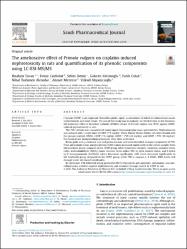The ameliorative effect of Primula vulgaris on cisplatin-induced nephrotoxicity in rats and quantification of its phenolic components using LC-ESI-MS/MS

Göster/
Erişim
info:eu-repo/semantics/openAccessTarih
2023Yazar
Turan, İbrahimCanbolat, Deniz
Demir, Selim
Kerimoğlu, Gökçen
Çolak, Fatih
Türkmen Alemdar, Nihal
Menteşe, Ahmet
Aliyazıcıoğlu, Yüksel
Üst veri
Tüm öğe kaydını gösterKünye
Turan, I., Canbolat, D., Demir, S., Kerimoglu, G., Colak, F., Turkmen Alemdar, N., Mentese, A., & Aliyazicioglu, Y. (2023). The ameliorative effect of Primula vulgaris on cisplatin-induced nephrotoxicity in rats and quantification of its phenolic components using LC-ESI-MS/MS. Saudi pharmaceutical journal : SPJ : the official publication of the Saudi Pharmaceutical Society, 31(9), 101730. https://doi.org/10.1016/j.jsps.2023.10173010.1016/j.jsps.2023.101730
Özet
Cisplatin (CDDP) is an important chemotherapeutic agent, accumulation of which in kidney tissue causes nephrotoxicity and renal failure. The aim of this study was to evaluate, for the first time in the literature, the protective effect of dimethyl sulfoxide (DMSO) extract of Primula vulgaris leaf (PVE) against CDDP-induced nephrotoxicity in rats. The PVE content was characterized using liquid chromatography-mass spectrometry. Nephrotoxicity was induced with a single dose of CDDP (7.5 mg/kg). Thirty female Wistar-Albino rats were divided into five groups (control, DMSO, CDDP (7.5 mg/kg), CDDP + PVE (25 mg/kg), and CDDP + PVE (50 mg/kg)). Biochemical and histopathological analyses were then performed. Rutin, gallic acid, p-coumaric acid and protocatechuic acid were identified as major components of PVE. Total antioxidant status and glutathione (GSH) values increased significantly in the serum samples from the treatment group compared to the CDDP group, while blood urea nitrogen, creatinine, oxidative stress index, malondialdehyde (MDA), tumor necrosis factor-alpha (TNF-α), total oxidant status, and 8-hydroxy-2′-deoxyguanosine (8-OHdG) values decreased significantly. GSH levels increased significantly in the treatment group compared to the CDDP group, while TNF-α, caspase-3, 8-OHdG, MDA levels and damage scores decreased significantly. In conclusion, PVE exhibited strong protective effects through its anti-apoptotic, antioxidant, and anti-inflammatory activities against nephrotoxicity and oxidative damage caused by CDDP in rats.

















